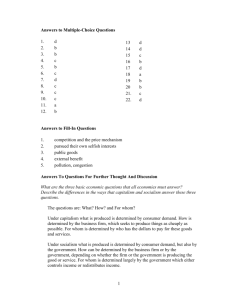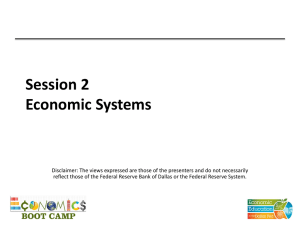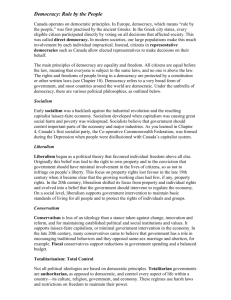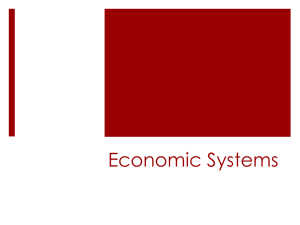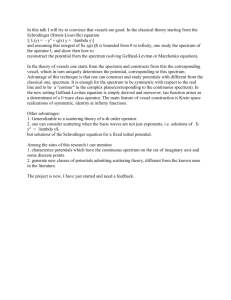ECONOMIC SYSTEMS
advertisement
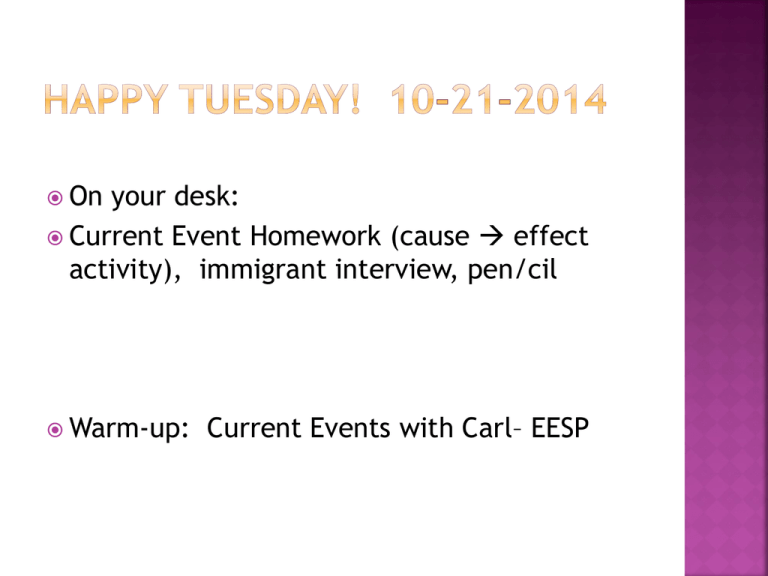
On your desk: Current Event Homework (cause effect activity), immigrant interview, pen/cil Warm-up: Current Events with Carl– EESP Would you have enrolled in AP Human Geography if given the opportunity as a freshman? TEXT to: 22333 YES= 123328 NO= 123369 1. current events 2. immigration essay- (test grade) 3. economic systems notes NEXT Major TEST is Friday Oct 31. 1. Interview and essay: TEST GRADE 2. current event homework (causeeffect from page R9 in text) 3. Ch 4 Vocabulary If you have completed all of these, you have NO HOMEWORK!!!! 1. How does geography influence how people make a living? 2. What are the 4 types of economic activities? 3. Mining, logging, fishing and farming are examples of what level of economic activity? 4. What is one argument in support of free trade? 5. What is one argument against free trade? Economic Activities: What people “do” for a living. 4 Categories.. Primary Secondary Tertiary Quaternary Shout out the level for the following pictures.. Making new items from Raw Materials Who makes the decisions within each economic system? On your notes page, list 2 things you already know or want to know about the four economic systems. Traditional Free Enterprise Communism Socialism Every society has limited resources. This means no society has enough goods and services to meet the needs of everyone. Because of this, each society must answer three economic questions. What should be produced? How should it be produced? Who should get it? The way in which society answers the economic questions is known as its “economic system.” Traditional Free Enterprise Communist Socialist Economic Decisions – custom and tradition determine what should be produced, how it should be produced and for whom. Production – based on custom and timehonored methods. New ideas are discouraged. Very little change or growth. Private Property – no private property. Things are owned by the family or village. Trade – goods and services are produced to meet the needs of the members of the family or tribe only. Very little trade with outsiders. Mostly found in rural, isolated areas Bushmen of the Kalahari Desert of South Africa Berber tribesmen of Algeria Villages in South Asia Private Property – people have a right to own private property and use this property as they see fit with limited interference from the government. Free Enterprise – people are free to take part in any business, buy any product or sell any legal product. Businesses can lower prices, provide better quality, advertise, etc. to attract customers. Profit Motive – the ability to make profits is what drives people to risk their money to start a new business. Supply & Demand – determines prices. When demand is high, the price goes up. If the supply is high but demand is low, the price goes down. Mostly found in countries with commercial agriculture and commercial industries. United States United Kingdom Canada Japan Singapore Chile France Germany (MDC’s) Role of Government – all major decisions on production, distribution and use of resources are made by the government. Private Property – no private ownership. The nation or government owns all land, factories, farms and major resources. Cooperation – all workers labor together and share equally. Major Goal – to achieve a “classless” society – equality among all workers. At one time there were MANY communist countries, but they were unable to keep up with the goods created by free enterprise systems. China – taking steps toward free enterprise. North Korea Vietnam Cuba Role of Government – government uses its power to bring an end to poverty by taking control of the major resources of the nation and providing public services. Economic Decisions – many decisions about production, distribution and the use of resources are made by the government. Other decisions are made privately. Private Property – major industries are owned by the government. Other property is owned privately. Major Goal – seeks a fairer distribution of income among society. People’s basic needs are met for free or at a very low cost. (healthcare, transportation, housing, education) After World War II, most countries in Western Europe became Socialist, but many moved toward privatization in the 1980’s and 1990’s. Today: Sweden Venezuela Israel In the real world, no economy TOTALLY follows one economic system. Most countries have economies that blend features of each. Countries can be classified on a spectrum ranging from free enterprise to communist based on how much control the government has. Socialism Communism Free Enterprise On your notes page, use what you’ve learned to fill in the “who makes the decisions” chart. You may work with a partner. Then draw a picture representation of each type of economic system. Next class period we will look at specific countries and place them on a economic systems spectrum. You will be placed in groups of 4. Assign the following duties: Time Keeper – keeps time and keeps group on task Librarian – reads information Secretary – gather materials and keeps notes Illustrator – draws spectrum and records countries ALL GROUP MEMBERS – PARTICIPATE IN DISCUSSION Materials: Country packet 1 sheet of notebook paper Pen/pencil Butcher/construction paper 1 or 2 markers Instructions: Read each country’s economic information Determine what type of economic system each country has and take notes over characteristics of each country Draw an “Economic System Spectrum” on butcher/construction paper. (see example) Review notes from each country and decide where each country should be placed on the spectrum Be ready to support your group’s decisions


